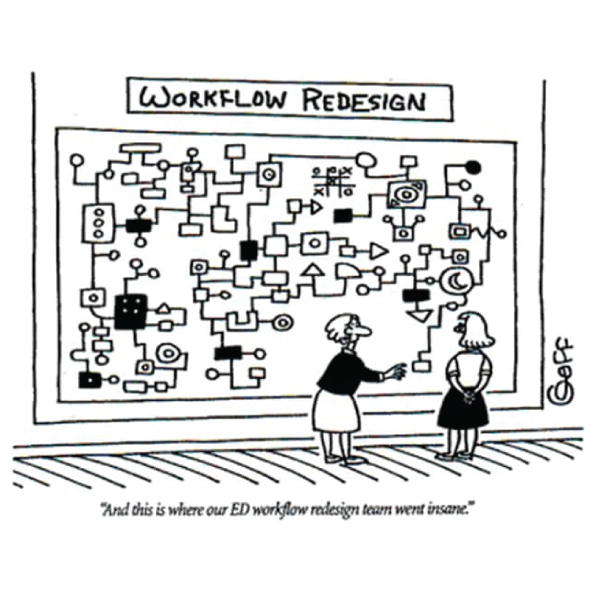We humans love to plan. Right from a young age, we develop our planning skills through family calendars and daily checklists before we ever step into kindergarten where planning becomes foundational to our day to day lives.And we are always planning once done school – our careers, our weekends, and onto buying houses, marriage, retirement and even what happens when we end our waking days. Yet, this inherent character to plan out our lives does not seem to find a way to infuse itself into CRM implementations.
We’ve all heard the statistics thrown about that half of all CRM implementations end in failure.And one of the top reasons shared by companies is a lack of CRM strategy…also known as a lack of planning. I personally believe there are many reasons for this, whether it be a belief that the technology will drive the strategy (focusing only on the tech and believing moving to this new application will fix everything), a lack of time (so many companies start their salesforce journey by having it emulate their old CRM application, usually with a go live date set by the expiration of their old CRM’s licenses) and a lack of resources to complete the appropriate amount of planning (this is very common with our small businesses and organizations that we have worked with in the past).
This underscores a critical truth: the foundation of a successful Salesforce implementation lies in pre-implementation preparation and strategic foresight. Without these, even substantial investments can lead to suboptimal outcomes.
To steer clear of such pitfalls, we have five steps before engaging with an implementation partner, including what it is, why it’s important, and best practices to keep in mind for each step.
Clearly Define Your Business Objectives
Establishing clear business objectives is the cornerstone of a successful Salesforce implementation. These objectives should be specific, measurable, achievable, relevant, and time-bound (SMART). For instance, aiming to increase sales revenue by 20% within the next fiscal year or reducing customer service response times by 50% are concrete goals that provide direction and purpose. Each department or group that will utilize Salesforce should go through this process, looking at their organizational goals, and defining what Salesforce can assist with. A great blog post was written on what SMART goals are with examples by Donald Kelly, the CEO of The Sales Evangelist and posted on Salesforce’s 360 Blog.
So, what makes this step so important? Clear objectives serve as a roadmap, guiding the configuration and customization of Salesforce to meet your organization’s unique requirements. They enable measurement of success post-implementation and ensure that all efforts are directed towards tangible business outcomes.
Best Practices
Align with Strategic Goals: Ensure that your Salesforce implementation objectives align closely with your broader strategic initiatives, guaranteeing that the CRM system enhances overarching business aims.
Diverse Engagement: Involve as many people as possible, from key stakeholders to end users. Having a wide range of people and roles from your company allows you to gather diverse perspectives and foster a sense of ownership and consensus for the implementation and solution.
Map Your Current Processes and Identify Pain Points
A thorough understanding of existing business processes is vital for tailoring Salesforce to your organization’s needs. Documenting these processes helps identify inefficiencies and areas where automation can be beneficial. Even if no one in your organization has completed process map documentation before, even documenting in a document or spreadsheet app as a list is a valid start to move forward to identifying pain points.
Now, the meetings you have when defining these processes should have a meeting facilitator. In my experience, these meetings when done correctly can lead to a unified process based on all points of view. A perfect example of this is in the famous Ted Talk, How To Make Toast.
Best Practices
Process Mapping: If possible, create visual flowcharts of current workflows to visualize each step and identify redundancies or bottlenecks. And if you are a smaller organization or you do not have someone who has experience in process mapping, incorporate this as a deliverable in your implementation of Salesforce.
Meeting Etiquette: When meeting to discuss processes, it’s important to have everyone’s point of view. One tip I would share is to have everyone bring their opinion of what the process the meeting is about defined (drawn out or written in a doc) prior to the meeting.But, the meeting should be a safe place for everyone to give their opinions and input.
Prioritize your Features: Must-Have vs. Nice-to-Have Requirements
Salesforce offers a vast array of features and functionalities, and it is more likely than not that one of Salesforce’s Clouds (and their individual features) is the reason (or reasons) you are planning for a Salesforce implementation. But before you look at what Salesforce can do for your company, you need to understand the underlying requirements that your company. And once you have completed your requirements gathering, you can then organize these from most important down. A great post on how to run successfully gather requirements can be found at Salesforce Ben.
Why prioritize these? Focusing on essential features prior to your implementation will assist in preventing scope creep, ensures a streamlined implementation process, and maximizes return on investment. As you have prioritized your requirements, It also allows for phased rollouts, which we discussed in a previous blog post on how it increases the success of your implementation.
Best Practices
Needs Assessment: Evaluate your organization’s requirements independent of the technology you are implementing. When you begin the implementation, you can determine which Salesforce features directly align with your immediate business objectives.
Prioritization Matrix: Develop a matrix categorizing features based on impact and urgency, facilitating informed decision-making.
Establish a Realistic Timeline and Budget
Setting achievable timelines and budgets is critical to the success of the implementation. Overly ambitious schedules or underestimated costs can lead to project overruns and stakeholder dissatisfaction. One way to establish a realistic time frame is to share your timeline and budget with your prospective implementation partner (or internal implementation team) and come to a consensus on what the timeline and budget would be based on your requirements and needs.
A well-structured plan ensures resources are allocated effectively, the project progresses smoothly, and stakeholder confidence remains high throughout the implementation.
Best Practices
Phased Approach: Break down the project into manageable phases, allowing time for testing, feedback, and adjustments. We wrote on why we wholly believe in this phased approach (also known as crawl, walk, run) in a previous blog post.
Contingency Planning: Allocate resources for unexpected challenges to prevent delays and budget overruns.
Prepare Your Internal Team for Change Management
The success of a Salesforce implementation heavily relies on user adoption. Preparing your team for the transition fosters a positive reception and maximizes the platform’s benefits. Early communication about the upcoming changes and clearly explaining how Salesforce will improve workflows and productivity can greatly enhance buy-in. Additionally, proactively addressing employee concerns, demonstrating empathy, and regularly providing updates on the implementation process builds trust and reduces resistance.
So, why? Effective change management cultivates a culture of adaptability and continuous improvement. It ensures the new system is utilized effectively, leading to improved productivity and morale.
Best Practices
Comprehensive Training: Invest in training programs tailored to different user roles, ensuring team members gain proficiency.
Continuous Support: Establish support channels to promptly address user concerns, facilitating a smoother transition.
Bonus: Testing an Implementation Partner through Requirements
Many organizations lack the internal expertise or resources necessary to accurately gather, document, and define requirements, critical factors for a successful Salesforce implementation. Selecting the right implementation partner can also be challenging, as it requires assessing not only their technical expertise but also their cultural fit with your organization.
One effective way to both complete this essential preparatory step and simultaneously evaluate a potential partner’s fit is through a focused engagement specifically aimed at developing your Salesforce requirements and CRM strategy. By partnering with an implementation consultant in this preliminary phase, you leverage their industry experience to produce a clear and actionable requirements plan without immediately committing to a full-scale implementation.
This strategic approach allows your organization to test the partner’s capabilities, communication style, and overall alignment with your company’s culture and vision. Ultimately, it reduces risk, ensures clarity moving forward, and helps you confidently select the ideal partner for your Salesforce implementation.
Wrap Up
So, there we are – our 5 step (well, 6 if you include the bonus) preparation plan. By following these essential steps, your organization can ensure a Salesforce implementation that’s aligned with strategic goals, maximizes your return on investment, and sets you towards CRM adoption and success.
However, if your team needs expert guidance to clearly define your business objectives, document your CRM strategy, or better understand the Salesforce landscape, our experienced team is here to help. Contact us today for a personalized consultation, and let us help you plan for a successful Salesforce implementation tailored specifically to your business.




